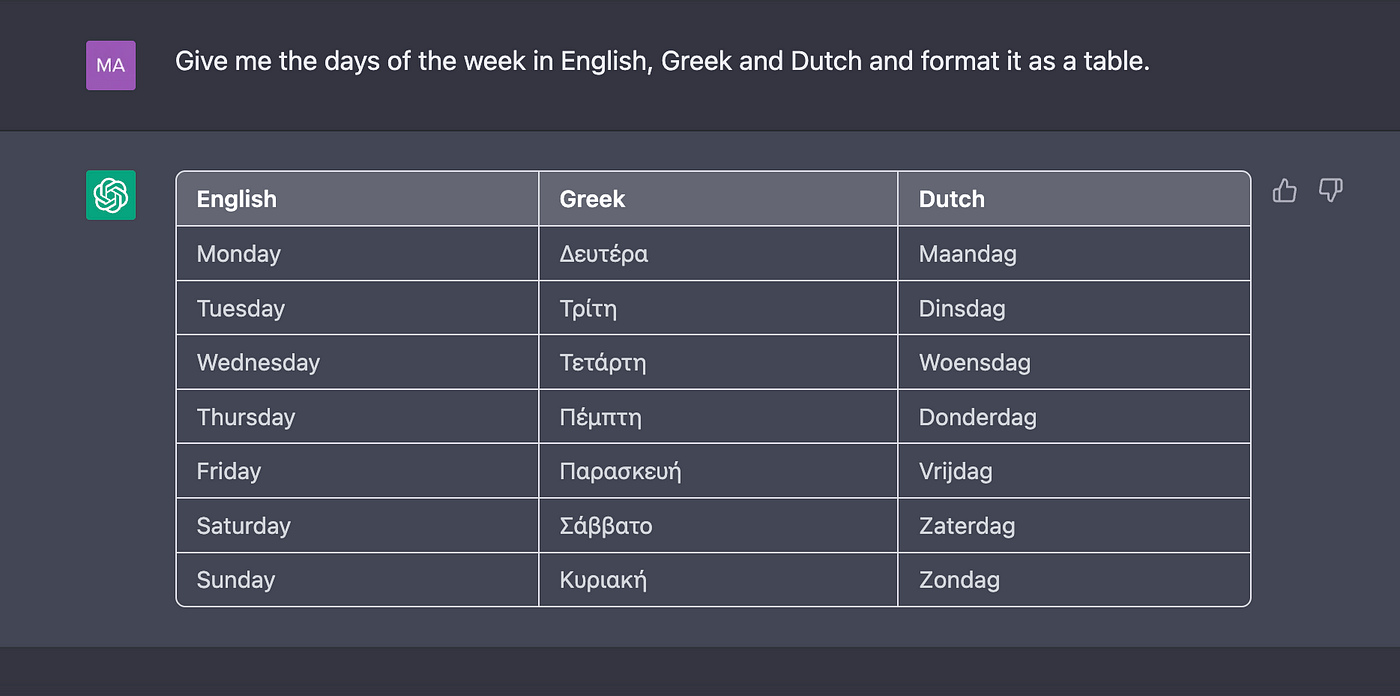In recent times, ChatGPT and similar AI tools have democratized access to artificial intelligence. These tools can generate responses on a wide range of topics, from sonnets and code to philosophy and more. While you can input almost anything into ChatGPT and expect a response, there are methods to elicit more engaging and useful results from the AI. This skill, often referred to as “prompt engineering,” is becoming increasingly specialized.
By simply adding a few extra words or an additional line of instruction, you can elevate ChatGPT responses beyond the ordinary, as demonstrated in the examples below. It’s worth noting that we tested these techniques with GPT-4, the latest ChatGPT version available at the time of writing. However, these strategies should also work effectively with older versions of ChatGPT.
- Present Information in Tabular Form
ChatGPT can provide responses in the form of tables, which can be highly useful for organizing information or brainstorming creative ideas. For example, you can create tables for meal ideas and ingredients, game concepts and equipment, or the names of days of the week in various languages. By using follow-up prompts and natural language, you can modify these tables and even export them in a standard format compatible with other software, such as Microsoft Excel.

- Craft Text in the Style of Your Preferred Author
With precise prompting, you can steer ChatGPT away from its default, matter-of-fact tone and towards the style of your favorite author. Whether you prefer the simplicity of Ernest Hemingway, the lyrical rhythm of Shakespeare, or the density of Dickens, ChatGPT can emulate these styles, offering a creative twist to its output.
- Set Constraints on Responses
ChatGPT can produce impressive results when given specific constraints to work within. Feel free to instruct the AI to limit responses to a certain word count or paragraph length. This can involve condensing information into a concise format or requesting answers composed of words with seven characters or fewer. If ChatGPT doesn’t follow your instructions precisely, you can guide it, and it will make adjustments accordingly.
- Tailor Responses to Your Audience
You can influence how ChatGPT responds by specifying the intended audience. Similar to explaining complex subjects to various levels of understanding, you can inform ChatGPT that you are addressing either a group of 10-year-olds or a gathering of business entrepreneurs. The AI will adapt its responses accordingly, allowing you to generate multiple outputs on the same theme.
- Generate Prompts for Other AI Engines
ChatGPT excels at prompt engineering and can generate creative inputs for other AI engines like Dall-E and Midjourney. You can request text from ChatGPT and then input it into other AI tools for experimentation. By providing detailed and specific instructions, you can refine the chatbot’s responses and enhance their quality.
- Obtain ASCII Art Outputs
While ChatGPT primarily deals with text, you can engage it in creating ASCII art, which consists of characters and symbols rather than colors. While it may not produce award-winning artwork, it can be an enjoyable creative exercise. Remember to provide clear and specific instructions for better results, keeping in mind the limitations of the ASCII art format.
- Copy and Paste Text from External Sources
You can streamline interactions with ChatGPT by copying and pasting text from external sources. While there’s a word limit of around 4,000 words for input, you can divide longer text into sections and ChatGPT will retain context. This approach is particularly useful for simplifying complex content or translating text into different languages while maintaining a coherent style.
- Provide Examples as Context
Enhance ChatGPT’s responses by providing it with examples before posing a question. For instance, you can present a list of book summaries along with their genres and ask ChatGPT to assign the correct genre to a new summary. Alternatively, share your interests or preferences with the AI to receive tailored suggestions.
- Engage in Role-Play
ChatGPT can adopt different roles and personas based on your instructions. Whether it’s a frustrated salesman, an excitable teenager, or even an iconic figure like John Wayne, the possibilities for role-play are extensive. While these prompts may not have practical applications, they offer valuable insights into the capabilities of AI chatbots.

- Provide Ingredients for Enhanced Responses
To receive more comprehensive answers from ChatGPT, offer it ingredients or context before posing a question. For instance, instead of requesting a murder mystery scenario, provide a list of characters and settings. By providing additional details, you can enrich the responses you receive.
- Explore Both Sides of Debates
ChatGPT can provide nuanced responses by arguing both sides of an issue and presenting pros and cons effectively. Whether the topic is politics, philosophy, sports, or the arts, ChatGPT can offer insights from various perspectives, promoting a deeper understanding of complex issues.
These techniques empower you to make the most of ChatGPT’s capabilities and enhance the quality and creativity of the responses you receive. Experiment with these methods to unlock ChatGPT’s full potential.




